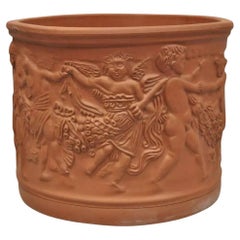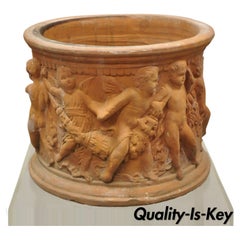Italian Red Terracotta Pots
Mid-20th Century Unknown Neoclassical Planters and Jardinieres
Terracotta
Recent Sales
Mid-20th Century American Classical Planters and Jardinieres
Terracotta
People Also Browsed
20th Century Beds and Bed Frames
Mahogany, Satinwood
Antique Mid-19th Century American Victorian Fountains
Concrete
Antique Late 19th Century American Victorian Grandfather Clocks and Long...
Glass, Wood
Late 20th Century Chinese Screens and Room Dividers
Wood
Antique 19th Century French Louis XVI Wall Mirrors
Gold
Late 20th Century Chinese Screens and Room Dividers
Brass
Early 20th Century American Arts and Crafts Windows
Stained Glass
20th Century Unknown Hollywood Regency Screens and Room Dividers
Wood
Antique Mid-19th Century French Louis Philippe Western European Rugs
Wool, Cotton
Antique 19th Century French Louis XVI Candelabras
Marble, Ormolu
Antique 19th Century French Louis XVI Vases
Crystal, Ormolu
Mid-20th Century French Candelabras
Crystal, Bronze
Antique 1780s Pedestals and Columns
Breccia Marble
Antique 19th Century French Neoclassical Wall-mounted Sculptures
Ormolu
Antique 19th Century North American Louis XVI Centerpieces
Ormolu
Antique Early 1900s Persian Tabriz Persian Rugs
Silk
Bitossi for sale on 1stDibs
Like a Fellini movie, the ceramics of the famed Italian company Bitossi Ceramiche embody a creative spectrum that ranges from the playful and earthy to the high-minded and provocative. Based in Florence, Bitossi draws on craft traditions that date back to the 1500s. These find expression in Bitossi pottery that includes artisanal vintage vases and animal figures by the firm’s longtime art director Aldo Londi, as well as the colorful, totemic vessels designed by the high priest of postmodernism, Ettore Sottsass.
Bitossi was incorporated by Guido Bitossi in 1921, though the family began making art pottery in the mid-19th century. In the 1930s, Londi came aboard, bringing with him a mindset that respected time-honored craft, yet looked also to the future. On the one hand, Londi’s perspective fostered the making of Bitossi’s popular whimsical cats, owls, horses and other animal figures, hand-shaped and -carved and finished in a rich azure glaze known as “Rimini Blue.”
But with his other hand, Londi reached out to thoughtful, experimental designers such as Sottsass. After hiring Sottsass to design ceramics for his New York imports company, Raymor, American entrepreneur Irving Richards connected the Milanese design polymath to Londi, who introduced Sottsass to ceramics in the 1950s.
During that decade, some 20 years before he founded the Memphis postmodern design collective in Milan, Sottsass used the Bitossi kilns to create timeless works that manifest both primitive forms and modern geometries. In later decades, Bitossi would welcome new generations of designers, which have included such names as Ginevra Bocini and Karim Rashid.
While always looking forward, Bitossi is firm in their belief that mastery of craft is the first step towards beautiful design. As you will see from the works offered on these pages, that is a winning philosophy.
Find a collection of vintage Bitossi decorative objects, lighting and serveware on 1stDibs.
A Close Look at Neoclassical Furniture
Neoclassical design emerged in Europe in the 1750s, as the Age of Enlightenment reached full flower. Neoclassical furniture took its cues from the styles of ancient Rome and Athens: symmetrical, ordered, dignified forms with such details as tapered and fluted chair and table legs, backrest finials and scrolled arms.
Over a period of some 20 years, first in France and later in Britain, neoclassical design — also known as Louis XVI, or Louis Seize — would supersede the lithe and curvaceous Rococo or Louis XV style.
The first half of the 18th century had seen a rebirth of interest in classical antiquity. The "Grand Tour" of Europe, codified as a part of the proper education of a patrician gentleman, included an extended visit to Rome. Some ventured further, to sketch the ruins of ancient Greece. These drawings and others — particularly those derived from the surprising and rich archaeological discoveries in the 1730s and ’40s at the sites of the Roman cities of Pompeii and Herculaneum — caused great excitement among intellectuals and aesthetes alike.
Neoclassical furniture is meant to reflect both grace and power. The overall appearance of neoclassical chairs, tables and cabinetry is strong and rectilinear. These pieces are, in effect, classical architecture in miniature: chair and table legs are shaped like columns; cabinets are constructed with elements that mirror friezes and pediments.
Yet neoclassicism is enlivened by gilt and silver leaf, marquetry, and carved and applied ornamental motifs based on Greek and Roman sculpture: acanthus leaves, garlands, laurel wreaths, sheaves of arrow, medallions and chair splats are carved in the shapes of lyres and urns. Ormolu — or elaborate bronze gilding — was essential to French design in the 18th and 19th centuries as a cornerstone of the neoclassical and Empire styles.
As you can see from the furniture on these pages, there is a bit of whimsy in such stately pieces — a touch of lightness that will always keep neoclassicism fresh.
Find antique neoclassical furniture today on 1stDibs.
Finding the Right Planters-jardinieres for You
Beautiful plants deserve beautiful homes. It’s time to introduce antique and vintage planters and jardinieres to your home’s interiors and outdoor garden area.
The word “jardiniere” has roots in French, but the appeal of these vessels is global. The popularity of jardinieres — ceramic pots intended for cut flowers or plants — quickly gained traction in the United States during the start of the 20th century, when you could find them in some middle- and upper-class American homes. Jardinieres had already been coveted goods overseas for at least a couple of centuries by then, as intricate planters crafted from Chinese porcelain or gilded-bronze versions from Japan could be found in the living rooms of wealthy Europeans.
Today, the love for planters and jardinieres knows no bounds. And whether you consider yourself a proper gardener or merely a doting plant parent, there is likely a use for a planter inside or in the lively outdoor space around your home.
Outside, a pair of marble and terracotta planters or cast-iron urns designed in the neoclassical style can add a stately touch to your landscape design while helping establish boundaries between the areas you’ve created for gardening and entertaining.
Bare corners in your living room or dining room can often be difficult to populate with furnishings that fit just so, and a planter can change that. While it’s possible to get maximal impact from minimalist pottery — an understated mid-century modern planter could deliver on that front — you might be pining for an on-trend planter with pizzazz. Look to an outwardly angular fiberglass design decked out in bright colors to give your blooms a run for their money, while mounted or vintage hanging vessels can serve as the frame for nature’s organic artwork, quite literally taking your gardening skills to the next level.
Browse a broad collection of antique and vintage planters and jardinieres on 1stDibs today.

